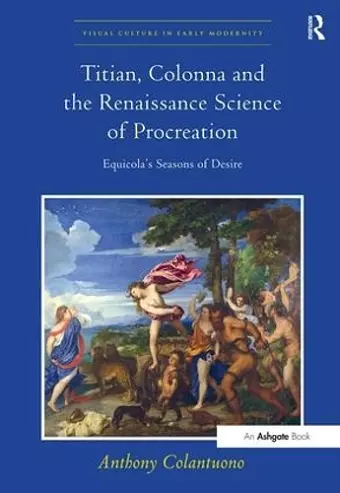Titian, Colonna and the Renaissance Science of Procreation
Equicola's Seasons of Desire
Format:Hardback
Publisher:Taylor & Francis Ltd
Published:1st Sep '10
Should be back in stock very soon
This hardback is available in another edition too:
- Paperback£52.99(9781138274709)

Titian, Colonna and the Renaissance Science of Procreation demonstrates that two major monuments of Italian Renaissance culture - Bellini's and Titian's famous series of mytho-poetical paintings for the camerino of Duke Alfonso d'Este of Ferrara, and Francesco Colonna's Hypnerotomachia Poliphili - were conceived as mnemonic or pedagogical devices aimed at educating the reader/beholder in the medical science of reproductive physiology and the maintenance of sexual health. It is further argued that the learned courtier Mario Equicola, who conceived the pictorial program of Duke Alfonso's camerino, had read Colonna's text and was extensively inspired by its prior literary argument. The study is organized in two parts, intimately interrelated. The first part is a study of Alfonso d'Este's camerino, with a general introduction, individual chapters on each of Bellini's and Titian's four pictorial "bacchanals," and a conclusion proposing a new and more accurate reconstruction of the layout of the room, also including a completely new way of interpreting the ensemble. The second part of the study concerns Colonna's Hypnerotomachia Poliphili, again beginning with its own introductory essay and advancing a completely new interpretation of the text. The brief conclusion brings the insights of the two sections together, clarifying the historical relationship between the pictorial and literary works and explaining their larger cultural significance. Emphasizing Equicola's use of the Hypnerotomachia as a model for pictorial invention, the author reveals how Titian's remarkably sensuous paintings and Colonna's erotically-charged romance are related by their common reference to the neo-Aristotelian medical theory of the "libidinal seasons," and by corollary themes of marriage and sexual consummation. This peculiar intersection of cultural themes came to prominence in the context of a courtly world in which medical science was increasingly brought to bear on the problem of dynastic continuity. While the book thus makes a major contribution to historical and art-historical inquiry into Renaissance notions of sexuality, it also relates this theme to the question of masculine identity and fatherhood, the histories of sexuality and marriage, and the interpretation of courtly art and literature as instruments of political or dynastic ideology. In addition, by grafting together the methods of advanced iconographic philology with those of comparative literature, the author provides a new methodological model that could be applied to other cultural monuments.
Rated as 'Research Essential' by Baker & Taylor
'This book sets a new standard for the analysis of Renaissance texts and for iconographic studies in art history. Rehearsing in compelling detail the process through which mytho-poetic inventions were conceived in Italy for courtly cabinet-paintings, Colantuono presents a fascinating re-reading of Bellini’s and Titian’s famous bacchanals, painted for Alfonso d’Este in the early sixteenth century. Informed by a neo-Aristotelian discourse on the natural (seasonal) causes of sexual desire, these paintings, we now understand, served to instruct the knowledgeable viewer on the healthful and productive management of the male libido, so important to the dynastic endurance of the d’Este and other Italian elites who constituted the paintings' viewing audience. Deftly combining erudite intellectual history with a situated excursus on the snares of libidinal desire and the efficacy of managing sex, this book presents a cogent interpretation of famously enigmatic pictorial texts and is a must read across the disciplines in early modern studies, offering a paradigmatic analysis of the production and reception of Renaissance art.' Karen-edis Barzman, Binghamton University, USA
'Any good book starts with a good question. In this case it’s a puzzle, involving a pseudo-Aristotelian text on the nature of the human libido, a series of celebrated Renaissance paintings and a riddle: how did Aristotle’s theories of procreation make it into Titian’s paintings and Colonna’s masterpiece? This book reads like a mystery with a philosophical, indeed Aristotelian, denouement. At one point I couldn't put it down... An extraordinary example of scholarship.' Cristina Perissinotto, University of Ottawa, Canada
'In Titian, Colonna and the Renaissance Science of Procreation: Equicola's Seasons of Desire, Anthony Colantuono examines erotic images of seminal importance to Renaissance iconography and sensibility. His investigations encompass a wide-ranging spectrum of literary and artistic sources concerned with mythology, medicine, witchcraft, and astrology, many of which have not been previously explored in this context... while Colantuono's study is sometimes imperfectly argued, there are many intriguing iconographic nuggets to be mined from it.' CAA Reviews
ISBN: 9780754669623
Dimensions: unknown
Weight: 1024g
344 pages